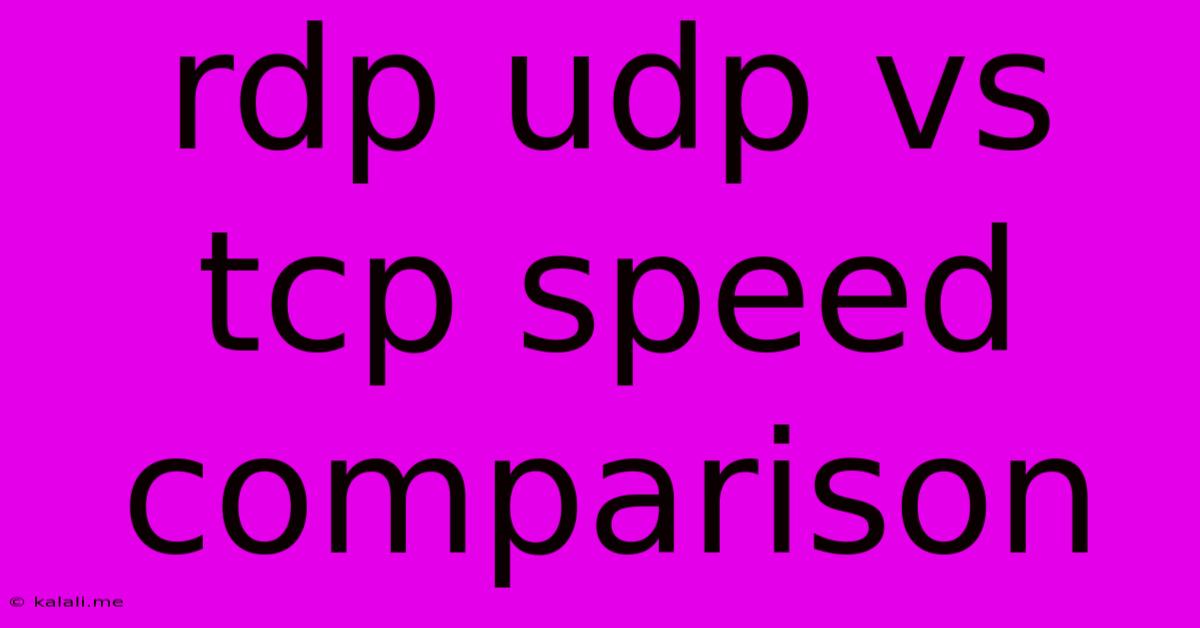Rdp Udp Vs Tcp Speed Comparison
Kalali
Jun 03, 2025 · 3 min read

Table of Contents
RDP over UDP vs. TCP: A Speed Comparison and When to Use Each
Choosing between UDP and TCP for Remote Desktop Protocol (RDP) connections significantly impacts performance. This article delves into the speed differences between RDP over UDP and RDP over TCP, exploring their strengths and weaknesses to help you determine which protocol best suits your needs. Understanding these nuances is crucial for optimizing your remote desktop experience and maximizing connection speed.
Meta Description: This article compares RDP over UDP and RDP over TCP, analyzing speed differences, strengths, and weaknesses to help you choose the best protocol for your remote desktop connection. Learn which option offers better performance and reliability.
Understanding TCP and UDP
Before diving into the RDP comparison, let's briefly review the fundamental differences between TCP and UDP:
-
TCP (Transmission Control Protocol): TCP is a connection-oriented protocol that guarantees reliable data delivery. It establishes a connection, checks for errors, and ensures data arrives in the correct order. This reliability comes at the cost of slightly lower speed. TCP is ideal for applications requiring data integrity, such as file transfers or web browsing.
-
UDP (User Datagram Protocol): UDP is a connectionless protocol that prioritizes speed over reliability. It doesn't establish a connection or check for errors, meaning data packets can be lost or arrive out of order. However, its speed advantage makes it suitable for applications where speed is paramount, even at the expense of some data loss. Examples include streaming video and online gaming.
RDP over TCP: Reliability at the Cost of Speed
RDP typically uses TCP by default. This ensures reliable transmission of all data packets, minimizing data corruption and ensuring a stable remote desktop session. However, the overhead associated with error checking and retransmission can impact speed, especially over high-latency or unstable networks. You'll experience consistent, though potentially slower, performance.
RDP over UDP: Speed with Potential Trade-offs
Using RDP over UDP prioritizes speed. By bypassing error checking and retransmission, data packets are sent more quickly. This translates to faster response times and a smoother user experience, particularly on networks with low latency. However, this speed advantage comes with the risk of data loss and potential instability. If packets are lost, it can lead to screen flickering, application crashes, or even a complete session disconnect.
Speed Comparison: The Verdict is Contextual
There's no definitive answer to whether RDP over UDP is always faster than RDP over TCP. The speed difference depends heavily on several factors:
-
Network Latency: On low-latency networks (like a local LAN), the speed difference might be negligible, with TCP offering reliable performance. High-latency networks (like satellite internet) will see a more noticeable benefit from UDP's speed, albeit at the risk of instability.
-
Network Bandwidth: With sufficient bandwidth, the impact of TCP's overhead is lessened. However, limited bandwidth might exacerbate the speed difference, favoring UDP's efficiency.
-
Network Stability: If your network is prone to packet loss, using UDP will likely result in a less stable RDP experience, even if initially faster. TCP's reliability shines in such scenarios.
-
Application Sensitivity: For applications requiring absolute data integrity, using TCP is non-negotiable. For less sensitive applications where a slight chance of data loss is acceptable, UDP's speed boost may be worthwhile.
Choosing the Right Protocol: A Practical Guide
-
Prioritize reliability: If data integrity and consistent performance are paramount, stick with the default TCP connection. This is generally the safest option for most users.
-
Optimize for speed on stable, low-latency networks: On a stable, low-latency network, experimenting with UDP might yield noticeable speed improvements. Carefully monitor your connection for stability.
-
Test and Monitor: The best approach is to test both protocols in your specific environment. Monitor your connection's stability and performance to determine which one offers the optimal balance of speed and reliability for your needs.
By understanding the strengths and weaknesses of both protocols, you can make an informed decision about which best suits your requirements, optimizing your RDP experience for speed and stability. Remember, the ideal choice isn't universal; it depends on your specific network conditions and application needs.
Latest Posts
Latest Posts
-
How To Reset A Liftmaster Garage Door Opener
Jun 05, 2025
-
Best Way To Knock Holes On Utility Tub
Jun 05, 2025
-
Why Cant I Transform Text Box Photoshop
Jun 05, 2025
-
Why Is My Serpentine Belt Squeaking
Jun 05, 2025
-
How To Move An Electrical Outlet
Jun 05, 2025
Related Post
Thank you for visiting our website which covers about Rdp Udp Vs Tcp Speed Comparison . We hope the information provided has been useful to you. Feel free to contact us if you have any questions or need further assistance. See you next time and don't miss to bookmark.